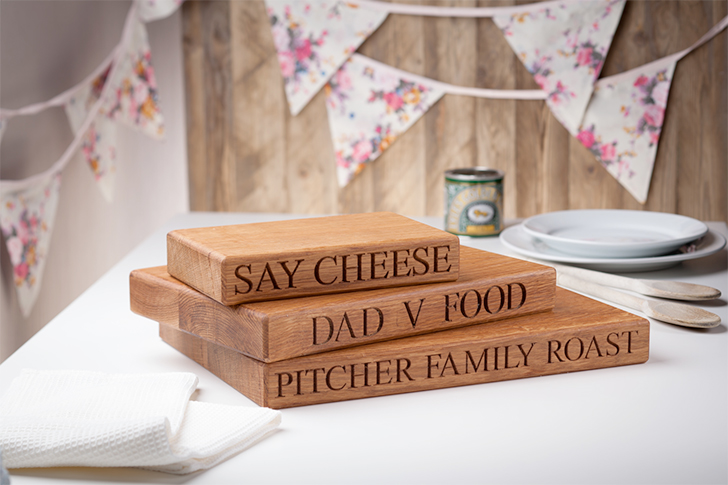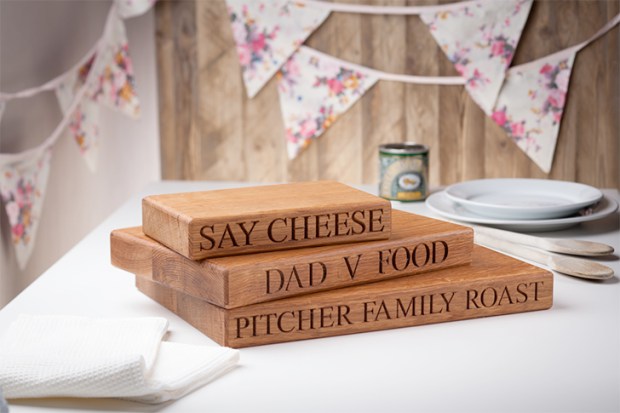When I was little I owned a set of pencils that had my name engraved on them. I didn’t have anything else with ‘Lara Prendergast’ on it other than my school uniform. The pencils seemed so rare and precious that I tried not to use them. The other day I found one stored away, the lead still sharp.
Personalised pencils aren’t too rare any more. In fact, stationery sits at the most mundane end of the personalisation spectrum. These days you can have your name on pretty much anything you buy. Personalised swings. Personalised bird feeders. A personalised ‘selfie’ toaster, which singes a picture of your face on to every piece of bread. Personalised tennis balls and horse saddles. Or a personalised quiver for your personalised arrows, perhaps. There are personalised jam-making kits and personalised pork pies. James Middleton’s company ‘Boomf’ does a range of personalised marshmallows. Prince George and Princess Charlotte must have received a box or two.
The personalised cheeseboard has become the present to give at weddings. One friend forgot to ask for just one, and found herself bombarded by the things, each stamped with the date of her wedding should she be at risk of forgetting it. ‘Personalised loo roll’ brings up 199,000 search results on Google. Tea bags, matchsticks, even condoms can all be stamped with your name. Or if you are feeling more romantic (or vain, depending on how you look at it), you can name a star or even personalise a seed so that your initials appear on the leaf.
It’s nothing new. The Greeks and Romans engraved their names on coins, and aristocrats and arrivistes have used coats of arms for centuries. But in the past decade the pace has accelerated at a terrifying rate.
The internet seems the most likely cause. Retailers can now sell directly to customers and have worked out that the ‘selfie’ generation will pay more for an item with their name or image on it. In 2014, Burberry started to offer the option of embossing a name on to their bottles of scent, which more than doubled sales — never mind that everyone wearing it smells exactly the same. NikeID lets you ‘build your own’ trainers and print your name on them; Ray-Ban ‘Remix’ is the same service for sunglasses. Aspinal recently launched a ‘chameleon’ service, which allows you to design your own tote bag. This lets you ‘take control’, apparently. ‘We have all become fashion designers,’ gushed one press release, as if remembering your own name while out shopping somehow turns you into Christian Dior.
There are laughs to be had. A friend’s uncle gave a large packet of M&Ms with his face on every single one as a thank-you present. For Christmas, another friend gave each family member a cushion with a close-up picture of his face on it. But, in general, personalisation results in more problems than laughs. You can’t re-wrap and palm off a set of ‘Lara Prendergast’ tea towels. You can’t even give them away to a charity shop.
And where does it end? What would life be like if all my possessions were personalised? I would wake up in my personalised sheets, drink coffee from my LP mug, with my name dusted on the foam in chocolate, using my personalised coffee-cup stencil. My house would be full of personalised pictures in personalised picture frames. Perhaps a personalised fruit bowl in the kitchen. I’d use my personalised travelcard holder to get to work. My personalised diary would be full of exciting appointments. In the evening, I’d open a bottle of personalised prosecco and fill up my personalised prosecco glass. Then I would move on to the personalised bottle of vodka. Before long, I’d lose the plot and use my personalised axe — £32.50 from notonthehighstreet.com — to lay waste to all my personalised objects. And when the time came, I’d be taken out in my personalised coffin, then buried, like everyone else, under a gravestone with my name on it.
Got something to add? Join the discussion and comment below.
Get 10 issues for just $10
Subscribe to The Spectator Australia today for the next 10 magazine issues, plus full online access, for just $10.
You might disagree with half of it, but you’ll enjoy reading all of it. Try your first month for free, then just $2 a week for the remainder of your first year.














Comments
Don't miss out
Join the conversation with other Spectator Australia readers. Subscribe to leave a comment.
SUBSCRIBEAlready a subscriber? Log in